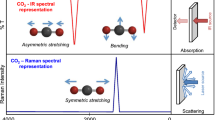Abstract
A new fluorescence at 333 nm formed when the solution of human neuronal tau protein was incubated at 37°C. The maximum excitation was at 230 and 280 nm respectively with the quantum yield of about 0.02. It took about 30 h for the complete formation of the new fluorescence and the light scattering increased with the formation procedure. It suggests that the fluorescence resulted from the aggregation of tau molecules in solution.
Similar content being viewed by others
References
Goedert, M., Jakes, R., Spillantini, M. G.et al., Assembly of microtubule-associated protein tau into Alzheimer-like filaments induced by sulphated glycosaminoglycans,Nature, 1996, 383: 550.
Goedert, M., Baur, C. P., Ahringer, J.et al., PTL-1, a microtubule-associated protein with tau-like repeats from the nematode Caenorhabditis elegans,J. Cell. Science, 1996, 109: 2661.
Goedert, M., Tau protein and the neurofibrillary pathology of Alzheimer’s disease,TINS. 1993, 16: 460.
Schweers, O., Schonbrum-Hanebeck, E., Marx, A.et al., Structural studies of tau protein and Alzheimer paired helical filaments show no evidence for β-structure,Journal of Biological Chemistry, 1994, 269: 24290.
Goedert, M., Spillantini, M. G., Potier, M. C.et al., Cloning and sequencing of the cDNA encoding an isoform of microtubule-associated protein tau containing four tandem repeats: differential expression of tau protein mRNAs in human brain,EMBO Journal, 1989, 8: 393.
Teale, F. F., Weber, G., Ultraviolet fluorescence of aromatic amino acids,Biochem. J., 1957, 65: 476.
Scott, G., Spencer, R. D., Leonard, V. J.et al., Emission properties of NADH. Studies of fluorescence lifetimes and quantum efficiencies of NADH, AcPyADH and simplified synthetic models,Amer. Chew. Soc., 1970, 92: 687.
Mar, P., José, M. V., Miguel, M.et al., Polymerization of τ into filaments in the presence of heparin: the minimal sequence required for τ-τ interaction,Journal of Neuro-chemistry, 1996, 67: 1183.
He, R. Q., Tsou, C. L., Fluorescence of peptide N-terminal 2-oxoacyl and quino derivatives,The Biochemical Journal, 1992, 287: 1001.
He, R. Q., Yang, M. D., Zeng, X.et al., Isolation and some properties of glycated D-glyceraldehyde-3-phosphate dehydrogenase from rabbit muscle,Biochem. J., 1995, 309: 133.
He, R. Q., Zhao, K. Y., Yan, Z. Z.et al., D-glyceraldehyde-3-phosphate dehydrogenase and maltotetraose-forming amylase from an Alcaligenes sp. during guanidine denaturation,Biochim. Biophysi. Acta., 1993, 1163: 315.
He, R. Q., Li, Y. G., Wu, X. Q.et al., D-glyceraldehyde-3-phosphate dehydrogenase during guanidine-HCl denaturation,Biochim. Biophysi. Acta., 1995, 1253: 47.
Author information
Authors and Affiliations
About this article
Cite this article
Luo, J., Li, W. & He, R. Formation of a new fluorescence of human neuronal tau protein. Chin.Sci.Bull. 44, 233–236 (1999). https://doi.org/10.1007/BF02896281
Received:
Issue Date:
DOI: https://doi.org/10.1007/BF02896281




